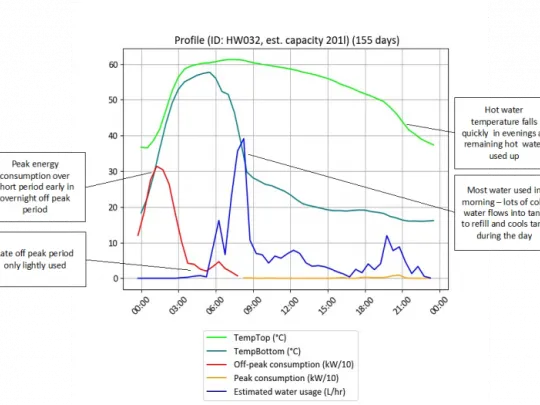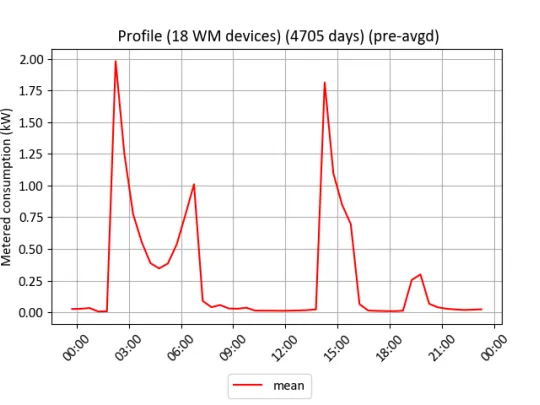Key information
Publication type: General
Contents
11 sections
Why is developing smart demand technology important?
Previous studies have shown that smart controllable demand that can be matched to low carbon energy supply can reduce the cost of the whole energy system by making best use of variable sources such wind and solar energy and maximising the energy that can be delivered through the grid.
What did Home Response do with Batteries?
Batteries were installed with smart controls that would reduce customers energy bills by :
- Storing energy from solar panels that would have been exported to the grid for no benefit, for use later in the day.
- Charging batteries from the grid at cheap times in order to reduce import at times when price is high.
- The ability to use the battery along with many others to provide support to the electricity system, by importing or exporting to control demand and other essential services to help manage electricity demand and balance the electricity grid.
Personalised usage profiles were developed for each customer to align the solar panel output with their consumption profile.
What did the Hot Water Controls do?
Hot water customers all used off-peak electricity (typically from midnight) to heat their hot water. Many people who heat their hot water like this may have limited supplies of hot water by evening time.
- Smart controls were fitted that measured water temperature and energy consumption to:
- Develop better profiles of hot water heating to provide same or better hot water with less energy input.
- To see if it was possible to temporarily turn hot water heaters on and off to provide flexibility services to the Electricity system without affecting customers hot water supply.
The Key Findings from Home Response
Home Response has shown that smarter energy controls, when combined with the right tariffs and services, can produce better customer outcomes, both in lower costs, better use of PV and better hot water outcomes.
Technology
The technology is capable of controlling demand as envisaged. Smart hot water controls could provide over 600MW of demand flexibility across London without affecting the customer experience. Electric storage heating represents a closely linked and equally significant opportunity that was outside the scope of the project to explore.
The project tried to use smart meters to control the service but this proved too difficult for small volumes. A solution for using the smart meter data network has been identified but it is likely to need to be supported by wi-fi / 5G communications.
Technology Standards are needed for both battery systems and hot water to ensure customers are able to access services from different providers. Discussions with other GLA programmes have highlighted that interoperability between different technologies and service providers is still very complex.
Rolling out smart energy technology
The individual opt-in approach used to recruit customers highlighted that embedding smart energy technology in systematic programmes is needed to ensure cost effective roll out.
Installing the battery technology was well understood and could be done independently of other household energy equipment and proved straightforward.
Hot water installations highlighted high numbers of legacy defects with customers’ existing installations that had to be addressed, requiring multiple visits by heating experts, electrical services and metering technicians. Integrating the expertise into teams that can work on multiple properties in the same location at the same time would be essential to a cost effective roll out.
Installing the individual smart controls used in the project could cost as little as £150 per property as part of a wider retrofit or refurbishment programme. High numbers of repeat visits drove this up to £500 per installation as part of the project.
The benefits to Landlords
Smart technologies that measure the performance of heating and hot water could offer benefits to landlords in addressing issues in properties (under and over heating, failure of heating systems) as well as the energy benefits to tenants.
But these technologies offer no benefits today in terms of either building performance scores or meeting decent homes standards, which are both significant factors driving investment in low carbon technologies. This significantly affects the business case for spending on these technologies and can lead to them being omitted from refurbishment programmes to the detriment of both individual tenants and of the whole energy system.
Service challenges
Providing services to the Electricity system from domestic customers proved challenging as most customers are not on suitable tariffs and it was difficult to find suitable tariffs for the trials. Market reforms due to take place in 2025, notably half hourly settlement, will make using domestic demand far easier.
What did we learn about hot water customers?
Customers water consumption patterns varied considerably. The water temperature over the day is strongly linked to when it is consumed as the tanks refill with cold water and are not automatically reheated.
All customers had peak electricity consumption immediately after the off-peak heating switched on around midnight. The peak lasted up to 3 hours, as hot water reached the thermostat limited temperature. There is significant scope for smart controls to manage this demand to deliver the same outcomes over the off-peak period as new off-peak low carbon electricity demands such as EV charging grow.
The chart below shows how water temperature (green lines) changes with usage (blue line). As hot water is used it is replaced with cold water and all the water cools down. This can lead to water not being hot enough in the evening, so people go without or have to use expensive peak priced electricity to top it up.

Water stats
Hot water heating creates a peak of demand at the start of the off-peak period. As EVs and other new low carbon energy needs will want to use off-peak electricity, smart controls offer the ability to spread the heating of hot water over the day.
There is a lot of potential for different electricity charging profiles to give customers better hot water outcomes at affordable prices, if backed up by affordable tariffs. Less energy would be lost from the tanks if the heating periods were closer to the periods of water use, which would also improve comfort for tenants. Being able to charge in two periods using E10 or dynamic tariffs was found to lower have the potential to lower costs and improve outcomes.
Analysis of dynamic tariffs (using 2019 price data more typical of normal markets) showed potential for better outcomes and costs savings using tariffs if they were used in conjunction with a managed energy service that adapted hot water charging times in response to prices.
Many customers who enquired did not participate as the project was only hot water and not storage heating too. Future smart electric heating control programmes should cover both heat and hot water.
What did we learn about batteries?
The average household with PV in Home Response produced slightly more energy than it consumes. The 4.8kWh battery was found to be reasonably sized for these households on a daily basis. The battery can store an average day’s excess solar for use in the evening.
There is a large variation in daily consumption and daily solar production, more than might be expected from only comparing the size of the installed PV. Some households produce far more than they consume and vice versa.
The battery has most value when PV production large enough for batteries to store significant energy.
The analysis has shown that the batteries and solar combinations in home response, optimised against Octopus Agile prices under normal energy market conditions, would reduce domestic peak consumption by 1.7KWh. Equipping homes with batteries has the potential to contribute significant flexibility to the grid.
Being able to show customers how they are benefiting from the smart management of the battery is important. Some national energy services can require energy be imported at expensive times but the rewards for doing it can exceed the costs. Crediting customers for each action is expensive to administer though. This suggests an ‘energy as a service’ customer offering may better suit the inclusion of complex energy flexibility services.
Solar panels reduce average C02 emissions but modelling based on the optimisation of battery usage around the cost for the customer indicated that importing energy might increase the carbon intensity due to the losses inherent in the battery system but this could change if the carbon intensity of electricity became more variable as the system decarbonises.
Energy Tariffs
To offer some of the more complex services to the electricity system the customer needs to be on ‘half hourly’ tariffs which are not readily available today for domestic customers. These are particularly important for some of the battery use cases and should become available with market reforms that are underway. Most of the battery customers in Home Response were on standard/flat tariffs.
Most hot water customers were on standard or Economy7 (E7) off-peak tariffs. E7 tariffs limit the window for flexibility into a short overnight period. In the short term, improving hot water services would benefit from the availability of tariffs that more flexibility than a single off-peak period (E7). Tariffs such as Economy 10 (E10) that offer three off-peak periods provide more potential for flexibility and improvements in hot water services. The project has identified examples of where this is already being implemented in London and elsewhere.

Energy stats
The diagram above illustrates an example averaged set of profiles for customers on an E10 hot water heating system and shows the different discrete times hot water is heated.
Home Response was able to switch one participant onto an E10 tariff and provide a bespoke hot water schedule. The Household has two residents, one at home by day and the other working. Hot water (HW) was originally charged at night from midnight.
The tenant switched by agreement to E10 with Utilita enabling cheap heat and hot water charging for ten hours: 04.00-07.00, 13.00-16.00, 20.00-22.00. The Lead tenant chose to have two HW heating periods - 05.00-06.00 and 15.00-16.00 - the times chosen match with one resident who showers in the morning and the other who showers on return from work after 16.00. They were very happy to have this option and eliminate the need to use the On Peak immersion heater which she does regularly.
E10 storage heating charging came as an unexpected bonus for the tenant especially the afternoon 13.00-16.00 period which is heating their high ceiling living room very well, though there is no automatic temperature control yet.
The project was not able to facilitate tariff switching for most customers due to the prevailing market conditions resulting from abnormal energy market prices not encouraging suppliers to take on new customers. The project was able to help one tenant switch to an E10 tariff.
Home Response’s work shows there may also be potential for customers to save on energy bills by switching to dynamic tariffs if supported by a suitably managed service which adapts hot water charging based time of day prices, while providing the same or better level of comfort. New commercial offers less dependent on kWh sales to consumers are needed to support smart energy solutions that can match supply and demand to minimise the costs of building a low carbon energy system.